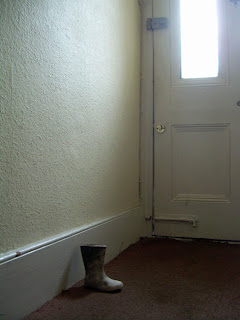"Even the most perfect reproduction of a work of art is lacking in one element: its presence in time and space, its unique existence at the place where it happens to be. This unique existence of the work of art determined the history to which it was subject throughout the time of its existence."
From 'The Work of Art in the Age of Mechanical Reproduction' Walter Benjamin.
I've spent the past couple of weeks researching theory and aspects of memorial in relation to architecture whilst simultaneously creating casts in the workshops. This has been successful in that each practice has informed the other, and has consequently changed the way I viewed my activities as they progressed.
 |
| Welly and plaster cast of the inside |
The idea behind the castings came from my thoughts on the cultural obsession with creating and preserving memories, and how often this process is taken to such extremes that the methods of preservation or remembrance overshadow, distort or even eliminate the accuracy of the original event. I decided to create memories of inanimate objects, in the forms of impressions, prints, photographs and castings, knowing that in order to complete this process the original object would inevitably be altered irreversably or even destroyed.

http://www.nwdrizzle.com/drizzle/0401/
images/ci/OrangeBath.jpg
Shoes, although inanimate, carry a strong human connection and can be emotive objects depending on their context and my choice of them as a starting point was a conscious one. The shoes were purchased from various London charity shops, and were selected from the 'rag bags' of donated objects which were deemed unsellable due to their worn condition. I wanted the casts of them to show this wear and tear in order to transfer the human connection... so that the casts would not simply be impressions of the interior space, but also carry of some of the emotional connotations from the objects and have a sense of history. Continuing this theme I decided to explore a slower and more visually poetic way of removing the casts using exposure to heat rather than simply cutting them free, and intended to leave lasting impressions not just of the original object but also of this process of removal.
 |
| The welly cast beginning to be revealed |
 |
| Shoe fabric melting and fusing with the cast |
Under the heat, the materials of the shoes (especially the rubber of the wellies) behaved differently to how I had anticipated. Rather than melting, the rubber tended to burn, bubble and discolour. The resulting casts are horrific. They seem to portray a narrative, evidence of a process or event which has occurred. The emotional reactions provoked by them is interesting though... because so far they have been viewed within the context of the workshops and studio - everybody knows the process which they have undergone, but viewers still feel uneasy in their presence.















